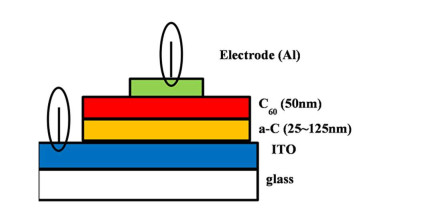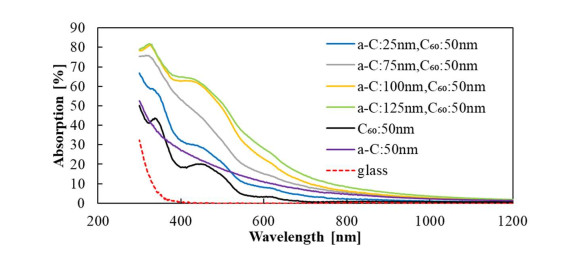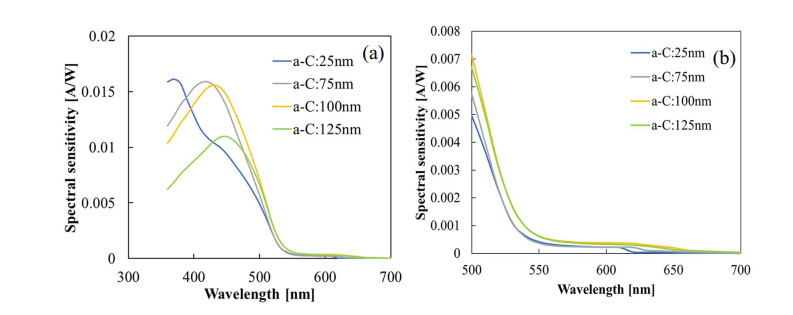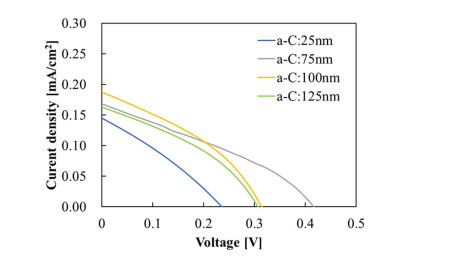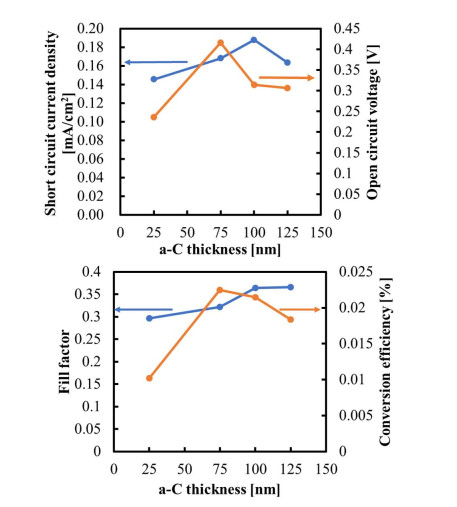1.
Introduction
Recently, global warming caused by greenhouse gases has become a worldwide problem. Solar cells have been attracting attention as a clean way to generate electricity to solve this problem. Currently, the mainstream solar cells use silicon, but the conversion efficiency has almost reached the theoretical value, and the high cost of high-purity silicon to produce high-efficiency silicon solar cells is a problem [1]. Therefore, next generation solar cells are being investigated, including compound solar cells such as GaAs [2], CdTe [3], organic thin-film [4], and perovskite materials [5].
As a next-generation solar cell, carbon-based materials are attractive in terms of resources and environment. Carbon is abundant element and can be synthesized from natural source. Moreover, it is possible to change the bandgap on demand by choosing the carbon allotrope, such as fullerene [6], nanotube [7] and graphene [8]. Furthermore, the band gap of amorphous carbon (a–C) can be changed from 0.5 eV to 3 eV with changing the sp2/sp3 ratio [9,10,11]. It means that amorphous carbon may convert the photons from UV-region to infrared region into electricity, resulting in the very high efficiency solar cell. In this context, we focus our attention on carbon materials for the next-generation solar cells using fullerene (C60) and a–C. C60 is known to be an excellent electron acceptor (n-type semiconductor) because it can stably accept six electrons due to the triple degeneracy of its lowest empty molecular orbital (LUMO) [12]. On the contrary, a–C is usually p-type semiconductor, and the optical gap of a–C can be changed by varying the deposition conditions [13,14].
Many papers are reported on C/Si junction solar cell until now [15,16,17,18,19]. But the merit of carbon is few if Si is used as a substrate. As all-carbon solar cell, several structures have been reported until now, such as C60/ITO [20], C60 homojunction [21], C60/single wall carbon nanotube (SWCNT)/graphene oxide (GO) [22], C60/diamond [23], etc. Chen et al reported the C60/ITO cell with short circuit current density (Jsc), open circuit voltage (Voc) and power conversion efficiency (PCE) of 1.98 mA/cm2, 0.52 V and 0.414%, respectively [20]. Kubo et al reported C60 homojunction solar cell with Jsc of 0.11 mA/cm2 [21]. Tung et al reported solution processed all-carbon solar cells from C60/SWCNT/GO with Jsc, Voc and PCE of 1.23 mA/cm2, 0.59 V and 0.21%, respectively [22]. Besides, C60/diamond cell with Jsc, Voc and PCE of 5.3 μA/cm2, 0.023 V and 4.3 × 10-5%, respectively, has been reported [23]. The authors reported a–C/C60 all-carbon photovoltaic devices with Jsc, Voc and PCE of 0.15 mA/cm2, 0.25 V and 0.01%, respectively, in 2013 by using the nature that a–C is p-type and C60 is n-type [24]. The a–C film was prepared by irradiating C60 in the process of sublimation with N2 radicals to break the bonds. Very recently, our group reported that a double junction carbon thin film cell using C60 and a–C (Al/C60/a–C/C60/a–C/ITO/glass) has twice the open circuit voltage compared to the single junction type, indicating tandem-like properties in this structure [25]. The thickness of each layer may affect the photovoltaic properties in two-junction carbon thin-film cells. Moreover, it was reported that nitrogen doping to a–C improved the short circuit current of a–C/C60 junction cell from 0.17 to 0.30 mA/cm2 [26]. However, so far, carbon thin-film solar cells have shown very low power conversion efficiency. We aim to fabricate carbon thin-film photovoltaic cells that show better power conversion efficiency by improving the device structure. In order to improve the performance, the thickness of each layer should be optimized. Although C60 film is commonly used as solar cell absorber, a–C is merely used because resistivity of a–C is high [9,26]. Therefore, it is expected that thickness of a–C layer greatly affects the properties of C60/a–C cell. In this study, the effect of the thickness of the a–C layer on the device characteristics was evaluated for single junction carbon thin film photovoltaic cells in order to improve the conversion efficiency of multi-junction carbon thin film solar cells.
2.
Materials and method
In this study, p-type a–C and n-type C60 were deposited on ITO glass substrates or glass substrates using an ultra-high vacuum chamber (UHVC). The base pressure of the UHVC is 10-8 Torr. A schematic diagram of the deposition system is shown in Figure 1. The deposition system consists of a turbo molecular pump (TMP), a load-lock chamber, a Knudsen cell, a high frequency power supply for generating N2 radicals and a quartz discharge tube, and others. C60 was deposited by heating and sublimating 99% pure C60 in a Knudsen cell. Also, the a–C was deposited by irradiating C60 with N2 radicals while it was in the process of sublimation in UHVC.
The sublimation temperature and pressure during C60 deposition are 500 ℃ and 3.0–6.0 × 10-8 Torr, respectively. And the sublimation temperature during a–C deposition is also 500 ℃, pressure is 8.0–9.0 × 10-5 Torr, RF power is 300 W, RF frequency is 13.56 MHz, and N2 flow rate is 1.5 sccm.
In this study, photovoltaic cells were fabricated by depositing a–C and C60 on ITO glass substrates, followed by the deposition of Al electrodes using a separate deposition system. In order to reduce the influence of the substrate as much as possible when measuring the absorptivity, we also fabricated samples with a–C and C60 deposited on a glass substrate. The schematic diagram of the fabricated photovoltaic cell is shown in Figure 2. The thickness of each layer was fixed at 50 nm for the C60 layer, and the thickness of the a–C layer was varied from 25–125 nm.
The samples were evaluated by measuring the current density-voltage (J-V) characteristics under AM 1.5 standard light using a solar simulator, and the photovoltaic parameters such as Jsc, Voc, fill factor (FF), and PCE were calculated from the J-V curves. The spectral response was measured with Xenon lamp (model PS-X500) and single-phase lock-in amplifier (model 5600A). The cell area is 0.09 cm2. The absorption coefficient was calculated from the results of reflectance and transmittance measurements by Ultraviolet Visible (UV-Vis) Absorption Spectroscopy (JASCO 670UV) on samples of a–C and C60 deposited on glass substrates.
3.
Results and discussion
3.1. UV-Vis absorption spectroscopy
The optical absorption of a–C/C60 single junction carbon thin film cells was evaluated by UV-Vis absorption spectroscopy to confirm the change in absorption spectrum when the thickness of the a–C layer was changed. In addition, samples of a–C and C60 monolayers formed on glass substrates with a thickness of 50 nm each and glass substrates alone were also evaluated. The reflectance and transmittance of each sample were measured by UV-Vis absorption spectroscopy, and the absorption rate was calculated from the results. The calculation of the absorption is based on the assumption that all the light incident on the sample is reflected, transmitted, or absorbed. The calculation results include the effect of the glass substrate.
The measurement results are shown in Figure 3. First, from the measurement results of C60 and a–C monolayers, it was confirmed that C60 has peaks at around 380 nm and 450 nm and absorbs light of wavelengths below 550 nm, which is a typical absorption spectrum of C60 film [27]. On the other hand, a–C has a broad absorption spectrum from the ultraviolet to around 800 nm as reported previously. From the Tauc plot the optical bandgap of a–C films is around 1.2 eV [20]. And the absorption spectrum for the sample of solar cell structure was confirmed to have the characteristics of both C60 and a–C monolayer. It was also confirmed that the absorption rate increased as the thickness of the a–C layer increased.
3.2. Spectral response
The spectral response characteristics of a–C/C60 single junction carbon thin film solar cells were evaluated when the thickness of the a–C layer was varied. Figure 4a, b show the measurement results of the spectral response characteristics for different current range.
From this figure, it was found that the fabricated photovoltaic cells generated electricity at wavelengths below 550 nm and the broad hump is observed at around 500–650 nm as shown in Figure 4b. This result and the measurement of the absorption suggest that most of the power generation in a–C/C60 single junction carbon thin film cells are due to the light absorbed in the C60 layer, and that the light absorbed in the a–C layer may have little role in the power generation. Also, as the film thickness of the a–C layer increases, the sensitivity decreases at wavelengths below 400 nm, and the peak around 400–500 nm moves to the longer wavelength side. This is thought to be due to the fact that light is absorbed by the a–C layer, since light passes through the a–C layer first due to the structure of the photovoltaic cell.
Our results suggest that the photons created in C60 contribute to current, whereas the contribution of a–C is very small. It is due to that the diffusion length of a–C is much shorter than that of C60. Based on these results, improving the minority carrier properties such as lifetime and mobility of the a–C layer is particularly important to increase the power conversion efficiency in a–C/C60 carbon thin film solar cells with highly-nitrogen doping [26], a-carbon nitride film [28], C3N4 [29], etc.
3.3. Photovoltaic properties
Photovoltaic properties of a–C/C60 single junction carbon thin film photovoltaic cells were evaluated when the thickness of the a–C layer was varied. The J-V characteristics of each sample under AM 1.5 are shown in Figure 5, and the variation of Jsc, Voc, FF, and PCE with the change of a–C layer thickness is shown in Figure 6. The measured photoelectric conversion parameters are shown in Table 1.
From Figures 5 and 6, it was found that there was a change in the photoelectric conversion parameters as the thickness of the a–C layer changed. The Jsc increased as the thickness of the a–C layer increased, reaching a maximum at 100 nm, and tended to decrease thereafter. The reason why the Jsc became smaller when the a–C layer was thin is thought to be that the a–C layer was not uniform, and current flowing in the opposite direction occurred in areas with a thin film thickness, which results in the decrease of spectral response at wavelength region of 400 nm to 500 nm as shown in Figure 4. Jsc decreases when the thickness of the a–C layer became thicker than 100 nm because of the increase in the amount of light absorbed by the a–C layer and the decrease in the amount of light reaching the C60 layer as the a–C layer became thicker, as well as the increase in series resistance due to the increase in film thickness. As in Jsc, Voc increased with increasing thickness of the a–C layer, reaching a maximum at 75 nm, and showed a decreasing trend thereafter. The reason why the Voc became small when the a–C layer thickness was thin is thought to be that the a–C layer was not a uniform film as in Jsc, and a current flowing in the reverse direction occurred via pin-hole or defects. The reason why Voc tended to decrease as the thickness of the a–C layer became thicker than 75 nm could be due to an increase of series resistance due to high defect density of a–C, which reduces Jsc. Fill factor is gradually increased with a–C thickness since the properties of a–C such as pin-hole or defect density is improved with thickness, resulting in the decrease of saturation current. From the variation of Jsc and Voc with the thickness of the a–C layer, PCE was maximum when the a–C layer was 75 nm.
In this experiment, the thickness of C60 was kept constant to 50 nm. When the C60 thickness is changed, the optimum thickness of a–C may be slightly changed. But these present results will be useful to understand the photovoltaic properties of a–C/C60 junction with different thickness.
4.
Conclusions
In this study, the photoelectric and optical properties of carbon thin film photovoltaic cells using C60 and a–C were evaluated when the thickness of the a–C layer was varied. As the thickness of the a–C layer was increased, the photoelectric properties improved up to a certain value, but deteriorated as the thickness increased. When the a–C layer is thin, it is not a uniform film, which is thought to be the cause of poor photoelectric properties, and each layer needs to have a certain thickness. In addition, the possibility that the light absorbed by the a–C layer hardly contributes to power generation is mentioned. Therefore, we believe that it is important to improve the minority carrier properties of the a–C layer by reducing defects, in order to improve the photoelectric properties.
Conflict of Interest
All authors declare no conflicts of interest in this paper.
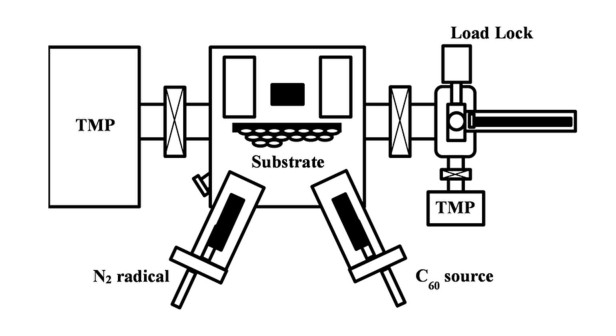









 DownLoad:
DownLoad:
